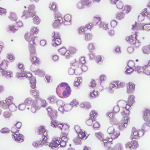“When you compare this to what we’re taught to look for in the heliotriope rash, it can be easy to miss—and indeed this was missed for a long time,” said Dr. Okoye.
A “trick” she uses to more easily identify erythema in people with darker skin is to examine them with a blue background—with a blue sheet of paper or blue fabric—which “usually makes the redness stand out a little bit more.” She also said that photos taken with a phone can sometimes allow a clinician to see redness even better than they can see with their own eyes.
She also said that, due to a crosstalk between melanocytes and fibroblasts, hypopigmentation or depigmentation can be a sign of fibrosis or scarring.1
“I think I see this the most, in the salt-and-pepper pigmentation of scleroderma, where the areas of fibrosis can lose pigment altogether,” she said.
Pigmentation can also be used to track someone’s response to therapy, she said.
Focus on Scleroderma

Dr. Hummers
Dr. Hummers said that many diseases can look a lot like scleroderma at first blush, forcing clinicians to be alert to telling distinctions.2
“Most of these diagnoses are clinically distinguishable without biopsy if you just think about some of these things,” she said.
She showed a photo of a hand that had some skin tightness and some pigmentary changes. “If you just looked at that hand, we would often say, ‘Well, that looks like systemic sclerosis,’” she said. “But that person has scleromyxedema.”
This disease, she said, is the “most scleroderma-like” of the mimics, with a distribution that is very similar but with the exceptions that it involves prominent skin changes around the ear, almost always with papules, and it does not spare the back, while scleroderma does. The skin quality resembles scleroderma as well, but with a “papular quality” and with the papules sometimes coalescing, leaving the skin just feeling thick, she said.
According to Dr. Hummers, a biopsy may help, but if one is ordered, a mucin stain should be specifically requested.
Diffuse scleroderma involves nearly the whole body, but it spares the mid-back, almost always spreads in a distal to proximal direction and always involves the fingers. The skin quality is thick and waxy and difficult to pinch, she said.
She emphasized the importance of including RNA polymerase III in labs becauseit’s linked to the risk of progression, the risk of a renal crisis and the presence of cancer.


